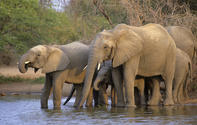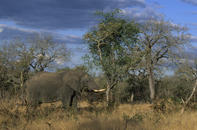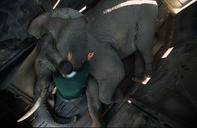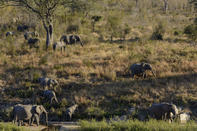Everybody Loves Elephants
Now here’s a hot-button issue… The Kruger National Park has a problem with elephants. There are simply too many of them. They are destructive eaters and impact heavily on the environment.

If something is not done, say SANParks, the Kruger’s biodiversity will be threatened. Thing is, everybody loves elephants. They are one of the park’s biggest draw cards and no-one wants to be part of a bloody culling campaign. After all, these are majestic and intelligent beasts. If you shoot them, do they not bleed?
The Elephantine Issue

This isn’t a new issue. Research done in the late 1960s suggested that the ideal elephant density is 1 pachyderm per 1 square mile. This equation puts the optimum Kruger population at 7000. A culling campaign started in 1967 and continued until 1995. During this time 14 500 elephants were killed and 2500 elephants were relocated.
In 1996, a moratorium on elephant culling was declared and SANParks initiated a series of workshops to try and find an equitable solution to the emotional elephantine issue. This was followed by the ‘Great Elephant Indaba’ in 2004. After much argument, it was agreed that the elephant population had to be managed to avoid the destruction of the park. Now the question is, how?
The Debate Rages On

Contraception is one alternative. But darts are expensive and the Kruger National Park is too large to make this practical. Relocation is another possibility, but elephants tend to migrate back to their old stomping grounds. It is also expensive and most reserves in Southern Africa are already fully stocked. Several Transfrontier mega-parks are being established, which should be able to hold greater numbers of elephant, but these might only come on-line in several years.
SANParks, for its part, maintains that elephant culling is the only viable solution and is ready to take action. And still, the debate rages on. Some opponents of culling have questioned the validity of the old ‘7000 elephants’ target. Others accuse SANParks of pushing the culling option because they profit from the sale of elephant hides and ivory.
‘Mega-Park’ proponents have urged the authorities to wait and see if the elephants spread naturally into the newly established Limpopo National Park in Mozambique. Then there are those who say that a natural elephant die-off occurs every couple of hundred years and any attempt to mess with one species will only cause imbalances in other parts of the ecosystem.
An Elephant Sized Argument

Amid all this talk, the SANParks is running out both patience and options. Several pro-culling advocates have even started sniping at international conservation organisations, the most vociferous opponents of culling. They say that the well-meaning foreigners have an overly sentimental reaction to the issue and no real understanding of the situation on the ground.
The great elephant debate remains unresolved for the moment. SANParks is still circling around the moratorium, looking for a way to lift the ban without causing too much bad feeling.
Their opponents are monitoring the situation intensely. It’s a potentially explosive situation – especially during times of drought (the recent drought of 2016 has already resulted in the limited culling of hippo and, potentially, buffalo). Whatever the outcome, to cull or not to cull remains a compelling question; one which does not have a simple answer.
By David Fleminger Wild animals in the Kruger National Park including 11 670 elephants, 150 000 impalas, 17 000 blue wildebeest, 9 000 giraffes, 3 000 hippos a...
Wild animals in the Kruger National Park including 11 670 elephants, 150 000 impalas, 17 000 blue wildebeest, 9 000 giraffes, 3 000 hippos a... Eager to keep the legend going, the Kruger National Park has launched the Emerging Tuskers Project ‘to identify all of the Park's large tu...
Eager to keep the legend going, the Kruger National Park has launched the Emerging Tuskers Project ‘to identify all of the Park's large tu...